
Blast mitigation and injury treatment
Even while inside the protective metal cocoon of an armoured vehicle, the force of a bomb exploding outside can shatter bones, toss limbs to extreme angles and hurl soft, delicate tissue against solid metal walls.
Soldiers serving in Afghanistan from 2001 to 2014 risked being caught in blasts such as these when travelling in vehicles. Within heavily armoured vehicles that had run over improvised explosive devices (IEDs), troops were sustaining injuries more severe than those seen in people who have fallen from six-storey buildings. The impact on those unfortunate enough to not have the protection of several inches of steel between them and the explosion was worse still.
It was a lesson the American and British troops were forced to learn repeatedly, as their patrols and vehicles were targeted by insurgents. As the war progressed, improvements in equipment, combat medicine, evacuation speed and advances in hospital treatment meant that more casualties from explosions were surviving than ever before. Yet this meant that more soldiers than ever were facing traumatic, life-changing disabilities.
One of the key devices developed simulates what happens inside an armoured vehicle caught in a blast and allows the investigation of what the intense blast of energy does to the lower limbs of soldiers
The military and the defence industry have been working to reduce or even prevent these injuries in the first place. The Royal British Legion Centre for Blast Injury Studies took the lead. Using the wealth of data and experience obtained from the war in Afghanistan, and previous conflicts, clinicians, scientists and engineers have worked together to find new equipment or changes in behaviour that may protect soldiers better if they are caught in an explosion.
The Royal British Legion has provided the centre with £5 million, support from other institutions and the military. One of the key devices developed simulates what happens inside an armoured vehicle caught in a blast and allows the investigation of what the intense blast of energy does to the lower limbs of soldiers. The results have led to key changes that will help lessen the number and severity of injuries. These include absorptive flooring and modified footwear and posture within the vehicle.
Blast matting
🎖️ How advanced materials science, structural analysis and testing combine to protect troops in military vehicles
New types of blast mats – used to line the floor inside armoured vehicles to absorb some of the energy from an explosion – have been found to help deflect the impact on the feet and help save the heels from injury.
Testing for blast mats requires engineering standards to be derived that can be related to specific injuries. The centre has been able to develop testing standards using crash test dummies (‘surrogates’) that allow the differences between mats to be quantified and recommendations to be made for which mats to use in military vehicles.
More recent work has been enabled by modern manufacturing technologies (3D printing) to design and fabricate different blast mat structures that are optimised to fail in the event of a blast, absorbing some of the energy and deflecting it away from the soldiers. This has required advanced materials science, structural analysis and testing to come together with design engineering to produce these strain- and loading-rate dependent structures.
The best-performing mats tested by the centre are now being used in military vehicles and were being used in Afghanistan before the last British troops pulled out in October 2014.
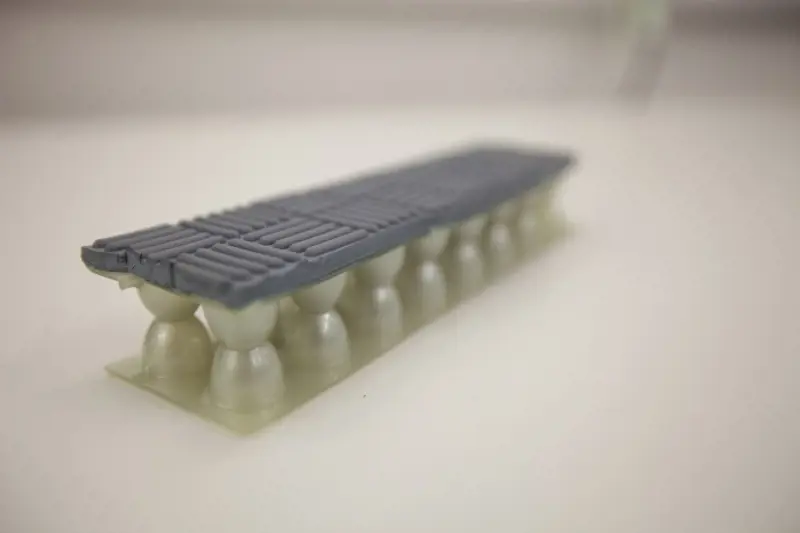
One of the blast mats tested at the Centre © Richard Gray
Blast impact
An IED buried in a road can send a blast of debris and super-heated gases flying upwards at speeds of up to 2,000 mph (3,200 km/h) into the belly of a vehicle passing above it. This can cause the metal plating designed to protect it to kick upwards violently. In just a fraction of a second, the metal accelerates, sending an impulse up into the feet, legs and body of anyone inside.
Each leg is loaded with sensors to measure the forces it comes under during the explosion
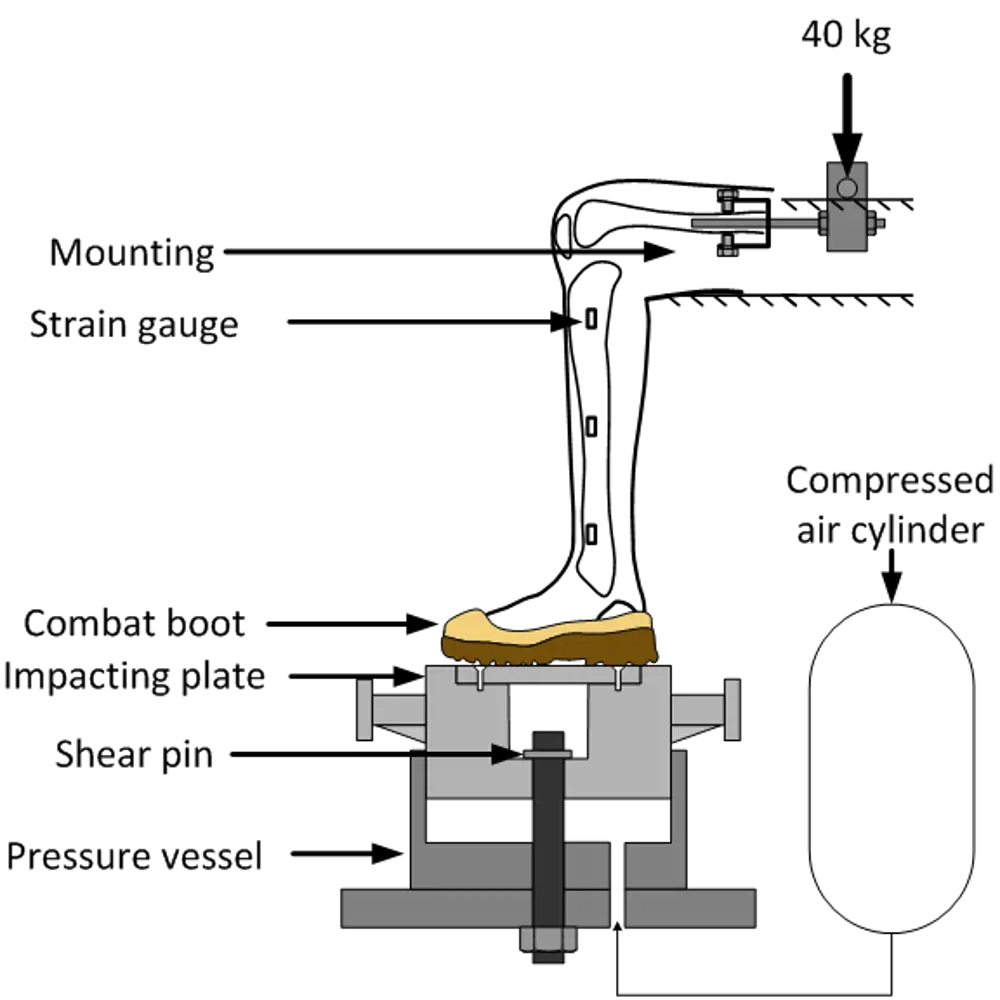
A sketch of the test arrangement in the centre’s traumatic injury simulator. AnUBIS replicates what happens to the floor of a vehicle when it is hit by an explosion from below. By mounting tissues, surrogates and real donated limbs, the effect of blast and mitigation technologies can be assessed © Royal British Legion Centre for Blast Injury Studies
The anti-vehicle underbelly blast injuries simulator (AnUBIS), developed by the Blast Injury Studies Centre, has a pneumatically-driven 42 kg plate that is released from a pressure vessel by a shear pin construct to accelerate to speeds of up to 55 mph (25 m/s). A model of a human leg, or a limb from a cadaver donated to science, can be placed on the plate. When the machine fires, these are thrown upwards, replicating what happens to a soldier sitting in a vehicle hit by a blast. Each leg is loaded with sensors to measure the forces it comes under during the explosion.
Housed in the basement of the centre on an eight-wheeled rig, this allows the research team to test what effect different body positions have on the damage done to the limb. Perhaps surprisingly, in the majority of armoured vehicle blasts, the most harm in survivors is done to the heels of the soldiers inside. At first glance, the injuries do not look nearly as traumatic as some of the other wounds that can be suffered, but the force of the metal floor driving up into the feet can shatter them so far beyond repair that they almost always require amputation.
Donated limbs that have been put into An UBIS before going through a CT scanner reveal how the bones in the heel are crushed by the upwards force. Yet the research team has been able to show that simple changes in posture within a vehicle can lessen these injuries. A standing position where the knees are locked, or hyper-extended, sustains the worst injuries, as there is a greater amount of mass being supported by the leg when the impact occurs. Such injuries are associated with a high probability of requiring amputation. In the battlefield, it is the gunners, who stand up inside the vehicle to reach the weapons mounted on top, who are most vulnerable to this. Those sitting down or adopting the brace position – where the knees are bent – suffer lower levels of injuries to their feet and are likely to make a full functional recovery. Through the very close research links with the Ministry of Defence, the findings obtained with AnUBIS have been passed on directly and considered in defining posture and placement of personnel within military vehicles.
These targeted links that the centre has made with the British armed forces are key to the translation of research findings
These targeted links that the centre has made with the British armed forces are key to the translation of research findings. There are military personnel, including medics who treat blast injuries, permanently embedded within the centre, each conducting two to three years’ worth of full-time research. Colonel Jonathan Clasper, a consultant orthopaedic surgeon and a senior officer in the army, has been key to this. He works in the centre in a joint military and clinical lead role and was instrumental in securing committed personnel and resources for the centre.
While not all of the recommendations arising from the centre’s work are implemented – some postures in a vehicle, for example, may be necessary for military operational reasons – their findings are making their mark – see Blast matting.
Head traumas
🖥️ Simulating head trauma to benefit soldiers, athletes and motorcyclists
New apparatus is also being developed to help simulate what happens to the head and brain during a blast. While modern army helmets are designed to stop bullets, there are few features in them to help protect against blast injuries.
Inside a vehicle, the head can be thrown violently against the side of the vehicle while the shockwave itself can cause damage to the tracts that connect different parts of the brain to one another. Already, computer modelling using medical scans of military personnel who have been involved in explosions is helping researchers to look at how certain incidents cause different injuries. They hope to use it to design new types of helmets for soldiers.
Yet the benefits of this work could extend far beyond the military into civilian realms of life. One of the key applications of this work is in contact sports, specifically American football – a sport that has been in the news lately over concerns about brain damage caused by the violent tackles and collisions on the pitch.
🏈 Read Ingenia's article covering the headband reducing the risk of brain injury.
Cyclists and motorcyclists could also benefit as new helmet technologies are developed. However, the level of energy involved in a road traffic accident is dwarfed by that experienced in an explosion. They are among the most traumatic insults the body can experience.

Diffusion Tensor Imaging (DTI) used to characterise microstructural changes in the brain. Researchers in the centre (Sharp and Ghajari) are currently assessing the micro-mechanisms of brain injury and the links with cognitive outcome in order to design mitigation systems © Royal British Legion Centre for Blast Injury Studies
Clothing protection
There were 265 British military personnel who sustained 416 amputations in Afghanistan between 2001 and 2014, with the majority needing both their feet and lower legs amputated. The US military suffered approximately 10 times as many amputees, and they too have now started sending researchers to the centre in London to take advantage of the interdisciplinary approach being taken there.
Simply doubling the thickness of the sole can also increase the level of protection. By changing the materials and construction of boots, however, it is possible to reduce the impact further still
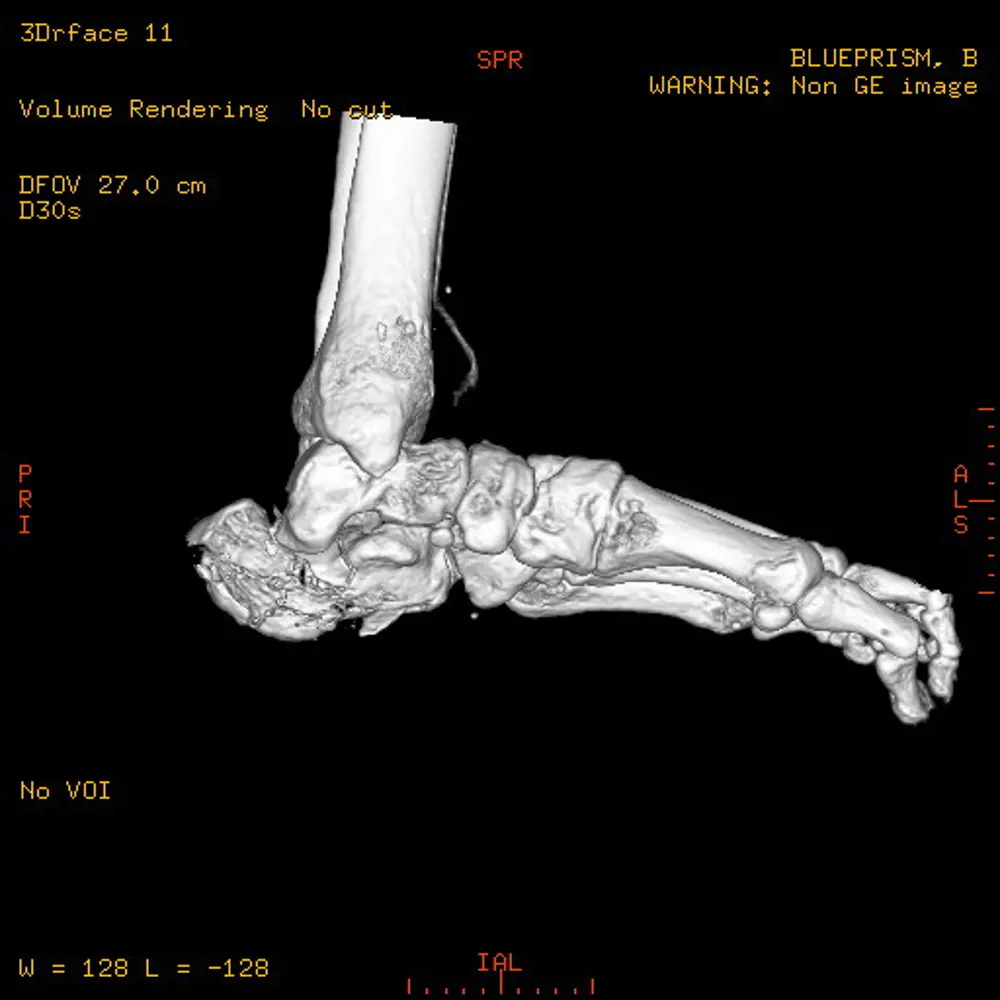
CT reconstruction of a cadaveric limb following testing in AnUBIS. It shows (when compared to battlefield CT scans) that the injury simulator can recreate the foot and ankle injuries seen in military operations © Royal British Legion Centre for Blast Injury Studies
It has been on the equipment worn by the soldiers themselves that some of the most significant work is being performed. Surprisingly few people had looked in the past at what happened to army boots during a bomb blast. Most had only been tested for their ability to resist impacts from running rather than the intense burst of energy thrown out by explosion.
A few bits of rubber, leather and fabric were perhaps thought to make little difference, yet the Centre for Blast Injury Studies has shown they could mean the difference between losing a limb or not.
Initial tests showed that some boots already worn by military personnel are better at withstanding impacts on the heel than others. The Meindl Desert Fox boots, which are the standard issue boots in the British Army, were able to transfer the peak force over a longer period of time than another type of boot often worn by soldiers. This could help to mitigate heel trauma due to underbelly blast.
Simply doubling the thickness of the sole can also increase the level of protection. By changing the materials and construction of boots, however, it is possible to reduce the impact further still. The team is working on the concept of frangible boots – footwear that can stand up to normal wear and tear on the battlefield, but when exposed to the extreme energies of an explosion tends to break up into fragments, rather than deforming elastically. A combination of real-life tests and computational modelling is allowing them to suggest new designs to the military. Advanced materials like shear thickening gels that become brittle under extreme force and rubbers that can be tuned to absorb these high energies can help to further reduce heel damage. Boots in the future could be used much in the same way as cycle helmets are – though once they have been in an explosion, they will need to be replaced.
Boots that can redirect the energy to other parts of the leg can also make a huge difference. Injuries sustained by soldiers in Afghanistan back this up. While some received devastating heel injuries that resulted in amputation, others sustained horrific-looking shin injuries.
According to clinicians dealing with blast injuries, even though these shin injuries look far worse, they are far easier to reconstruct and do not require amputation, resulting in better outcomes. So, rather than trying to stop the huge amounts of energy that can hit soldiers in the event of an explosion from an IED, it may be easier to redirect it to elsewhere on the body. While it will not stop soldiers from being injured, it will mean that their recovery will be far more successful. Around 25% suffer injuries to their head – see Head traumas.
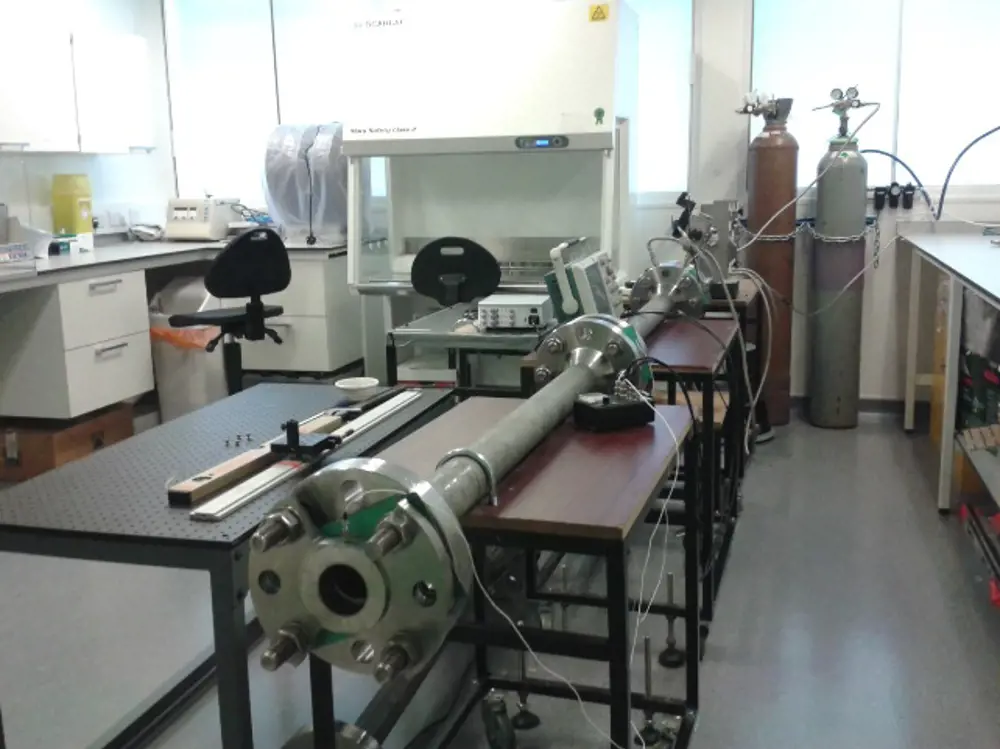
The Centre’s ‘tuneable’ shock tube that re-creates the loading experienced during various blast scenarios and is used to test the effect on physiological specimens and cells © Royal British Legion Centre for Blast Injury Studies
Cellular Engineering
The shockwave from an explosion can cause the cells of the body to react in unusual ways. Blast patients can suffer debilitating conditions such as heterotopic ossification, the unwanted formation of bone, in their stumps after amputation, often making it too painful for them to wear prostheses. In some cases, the bones can form in other parts of the body. Centre researchers are using mathematical analysis of molecular and cellular events to develop an understanding of the nature of traumatic and post-traumatic effects on live biological samples. This will help improve outcomes as well as provide information for the design and construction of new biological molecules and customised cells in regenerative medicine.
Using a shock tube developed in the centre – which uses compressed air to replicate explosions equivalent to 25 kg of TNT at 0.3 metres – tissue samples can be studied to see how the cells react. The results are suggesting that the blast wave produces a systemic effect on the stem cells that reside within bone around the whole body, causing them to malfunction. There are now hopes it may be possible to treat this with pharmaceuticals.
The interdisciplinary approach is exemplified further in the Centre’s work on smart sockets for prosthetics that enable monitoring of temperature, pressure and moisture inside the stump for improved fit and comfort for amputees. Equipment that tests the strength of different human tissues, such as tendons and ligaments, has also allowed the production of detailed computer models of human limbs to be constructed. Combined with the data from experiments conducted on AnUBIS, it is possible to accurately predict what the outcome of a particular explosion will be.
Far reaching
Combat casualty care has undergone significant advances in recent years. The progress made in areas such as pre-hospital care, expedited casualty evacuation and in-hospital resuscitation protocols for trauma cases has resulted in record survival rates from battlefield blast injury – 90% in Afghanistan.
Work of this kind, however, reaches far beyond the military. There are around 600 explosions every month worldwide, which leave people badly wounded. These include the legacy of landmines left buried from past conflicts, and injuries caused by terrorist attacks and industrial accidents. Indeed, civilian medicine has been greatly advanced by the heightened exposure of doctors to explosives-related trauma. Preventing injury in the first instance, and improving both the long-term health and quality of life of those disabled by blast injury is, however, reliant upon research in this field.
In July 2015, two men were killed in an explosion on an industrial estate in Hellesdon, Norwich. Then days later, four more people were killed and 35 injured, four seriously, at an explosion at a wood flour mill in Bosley, Cheshire.
Preventing injury in the first instance, and improving both the long-term health and quality of life of those disabled by blast injury is, however, reliant upon research in this field
Learning from the hard-earned lessons of the men and women who were fighting in Afghanistan may help to improve the treatment and care of civilians caught up in traumatic events. It could lead to better industry standards to ensure soldiers and employees are protected in the right way for the job they are doing. It will also mean better levels of recovery for those who are injured and better chances of getting them back on their feet.
The Royal British Legion Centre for Blast Injury Studies is now progressing to a new phase of research. It will focus more heavily on the translation of basic research and the use of its developed technologies, not only for mitigation and protection, but also for improved long-term outcomes through engineered rehabilitation and treatment solutions. The fact that blast injuries, both military and civilian, are still occurring with frequent and devastating effect means that the relevance and importance of this translational research activity is undiminished.
***
The author would like to thank Richard Gray – freelance science and technology writer – for his help in writing this article.
This article has been adapted from "Blast mitigation", which originally appeared in the print edition of Ingenia 65 (December 2015).
Contributors
Professor Anthony Bull FREng is Director of the Royal British Legion Centre for Blast Injury Studies and Head of Department of Bioengineering at Imperial College London. His personal research programme focuses on the basic mechanics of joints – including the tissues of joints and the mechanics of joints within the whole musculoskeletal system. His research team investigates ways to develop new technologies to diagnose and treat pathologies and trauma.
Keep up-to-date with Ingenia for free
SubscribeRelated content
Health & medical

A gamechanger in retinal scanning
2006 MacRobert Award winner Optos rapidly became a leading medical technology company and its scanners have taken millions of retinal images worldwide. There is even a display at the Science Museum featuring the Optos development. Alastair Atkinson, of the award-winning team, describes the personal tragedy that was the trigger for the creation of Optos.

Kidney dialysis
Small haemodialysis machines have been developed that will allow more people to treat themselves at home. The SC+ system that has been developed is lighter, smaller and easier to use than existing machines.

Engineering polymath wins major award
The 2015 Queen Elizabeth Prize for Engineering has been awarded to the ground-breaking chemical engineer Dr Robert Langer FREng for his revolutionary advances and leadership in engineering at the interface between chemistry and medicine.
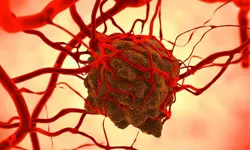
Targeting cancers with magnetism
Cambridge-based Endomag has helped treat more than 6,000 breast cancer patients across 20 countries. The MacRobert finalist uses magnetic fields to power diagnostic and therapeutic devices. Find about the challenges that surround the development and acceptance of medical innovations.
Other content from Ingenia
Quick read

- Environment & sustainability
- Opinion
A young engineer’s perspective on the good, the bad and the ugly of COP27

- Environment & sustainability
- Issue 95
How do we pay for net zero technologies?
Quick read

- Transport
- Mechanical
- How I got here
Electrifying trains and STEMAZING outreach

- Civil & structural
- Environment & sustainability
- Issue 95